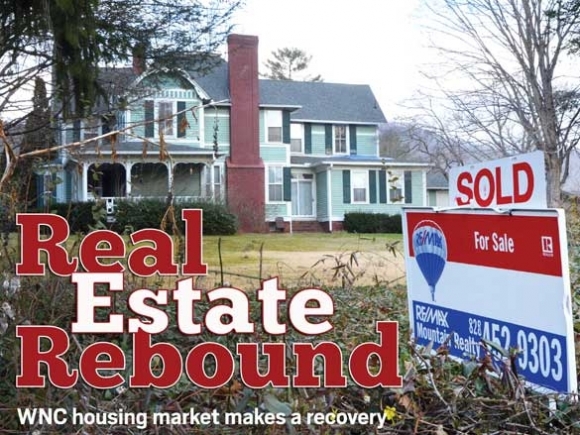Get real: WNC real estate market comes back swinging

Within the residential real estate industry lies an interesting contradiction.
SEE ALSO:
• Haywood housing demand is high but inventory is low
• Macon making sustainable growth in real estate market
• Real estate rebounding in Jackson
• Mountain cabins in high demand in Swain
While it provides one of humanity’s most basic and critical needs — shelter from the elements — it also plays a complex and important role in the global economy.
Accordingly, changes in the industry and the environment in which the industry operates can have dramatic repercussions on everything from one’s personal financial health to the wealth of nations.
In 2006, real estate construction in the United States accounted for $1.2 trillion in gross domestic product — good for an 8.9 percent share.
But a looming financial crisis would soon reshape both the industry and the environment, causing hard times for everyone from bankers to builders to bakers.
Related Items
In mid-2007, residential real estate prices began to slip; existing single-family home prices dropped 4 percent from their 2005 peak.
Although not disastrous on its face, the slump was exacerbated by Wall Street shenanigans, in the form of mortgage-backed securities. Banks peddled these securities to companies and individuals who were enamored with the assurance that they were safe investments that would bolster retirement portfolios.
The hedge against default on these securities was a financial product called credit default swaps, wherein the sellers of those swaps contracted to insure the buyer’s possible losses in the event of a default.
Everything would have been just fine in 2007 had borrowers continued to pay their mortgages. However, almost half of all mortgages created between 2005 and 2007 were sub-prime mortgages, which are issued to borrowers with less-than-perfect credit.
Since those mortgages represented an increased risk to lenders, interest rates were higher than conventional mortgages; as those buyers began to default under the strain, their sheer numbers overwhelmed the ability of lenders to compensate the holders of mortgage-backed securities against the losses.
American International Group was the largest issuer of such securities and quickly found itself with a weak cash position, so much so that in September 2008, the Federal Reserve had to give AIG a two-year, $85 billion loan to keep it afloat. Banks similarly situated — like Bear Stearns and Lehman Brothers — were either sold or entered bankruptcy, kicking off a nearly decade-long Great Recession, from which Western North Carolina is only now recovering.
In 2016, real estate construction in the United States accounted for $1.2 trillion in gross domestic product, finally returning to near-2006 levels of valuation; but that intervening decade saw trillions in market value evaporate as consequences reverberated through almost every aspect of the economy.
Home sales don’t exist in a bubble. Even the transaction itself involves multiple professionals who derive income from inspecting, repairing, advertising, selling, insuring, titling and closing the sale.
When a home is sold, it represents more than just a change in address for the buyer. It also usually represents a change in lifestyle — a renter becomes a homeowner, a couple welcomes a child into their lives, a speculator buys an income-generating property, a family purchases a vacation home, a retiring empty nester downsizes and a decedent’s estate liquidates.
Each of those very typical transactions involves associated purchases that create a powerful economic multiplication effect. That renter suddenly needs a lawnmower, that couple needs a minivan, that speculator needs appliances, that family needs a Jacuzzi, that empty nester needs a putting green and that estate needs an attorney.
Such consumer spending — defined as the sales of services, of consumables and of durable goods like lawnmowers and minivans — has historically accounted for between 60 and 70 percent of the U.S. economy.
Thus a downturn in the housing market can create a vicious circle of unemployment resulting in reduced consumer spending resulting in further unemployment resulting in that renter never quite being able to afford to buy their first home.
Given that most Americans’ single biggest asset is the equity in their homes, those who never achieve home ownership build wealth for speculators, but not for themselves, which contributes to a variety of social ills — from increasing wealth and class divisions to increasing stress on social safety net programs.
But where it can place the most stress, or the most largesse, is in the municipal budgets of local governments that rely on property taxes for the bulk of their revenues.
Haywood County, for example, derives 56 percent of its yearly revenue from ad valorem — more than $42 million. In Jackson County, it’s 48 percent.
That revenue figure is the product of two factors: the tax rate, and the value of the taxable property.
When that revenue declines — either by tax rate cuts, which are rare, or more commonly by a change in property value — it affects every service a county might provide, from general government and public safety to recreation and education.
Property values change when residential property is sold. If the buyer and seller have, through the influence of market forces, agreed upon a transaction that differs somewhat from the assessed value of the property, the property may be reassessed at a higher or lower rate.
Houses that remain under the same ownership for longer periods of time, however, are obviously not subjected to the regular reassessments that come with a sale. This is part of the reason why counties perform periodic revaluations of all taxable property.
Haywood County’s most recent revaluation was in 2011 — during the heart of the recession — but a revaluation is currently underway, with new valuations expected to be mailed to homeowners around Feb. 15.
Jackson County’s last revaluation was enacted Jan. 1, 2016, and actually produced a lower taxable value than had previously been estimated, resulting in the county having to raise its tax rate to keep the budget balanced.
Macon County revalued in 2015 and Swain County in 2013, as lingering economic woes continued to plague the market. Their next revaluations are slated for 2019 and 2021, respectively.
What can Macon and Swain expect from their upcoming revaluations? And what can Haywood County expect from theirs?
According to figures provided by the Haywood County Board of Realtors, the general trend is upward. Total sales volume in the county in 2016 increased by 19.4 percent over 2015, and the mountainous region of Western North Carolina saw gains of 9 percent over that same period.
Given that housing market depressions ripple through many economic sectors, market booms also create conversely cyclical effects that can spur economic growth — more lawnmowers and more minivans sold mean more jobs, higher pay and greater economic prosperity.
Probably most importantly, however, booms also mean more revenue for the taxing authority; were a revaluation to occur that set realistic taxable property values say, 10 percent higher than in the previous revaluation, that would theoretically lead to a 10 percent increase in property tax revenues.
In Haywood County’s case, that would amount to an extra $4.2 million, which could be used in any number of ways — like expanding the county’s yearly economic and physical development spending of $2.3 million by almost 200 percent, increasing the county’s yearly education spending of $15 million by 28 percent, or retiring a majority of the county’s long-term debt.
Alternatively, if budget spending levels remain constant year over year, that 10 percent increase could be refunded to taxpayers in the form of an again-theoretical 10 percent property tax cut, saving the owner of a $300,000 home about $170 a year.
But during a meeting of the Haywood County Board of Commissioners meeting Feb. 6, Haywood County Tax Administrator David Francis revealed that it was likely Haywood County’s overall valuation would be slightly lower than that of 2011, setting up a cut spending/raise taxes scenario due to decreased ad valorem revenue.
All of these theoreticals, however, depend on one thing — the revenue generated both during and subsequent to the sale of a home, which in turn relies on two basic influences — supply and demand.
The Smoky Mountain News recently spoke to buyers, sellers, brokers, lenders, and real estate agents in Haywood, Jackson, Macon and Swain counties to elaborate on supply and demand trends as well as the overall vitality of the market.
And although most professionals agree there is room for reasonable near-term optimism, each county faces different challenges it must overcome to continue emerging from the most significant economic downturn since the Great Depression.









